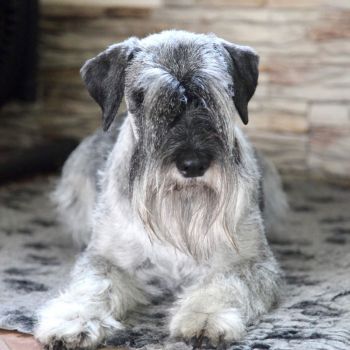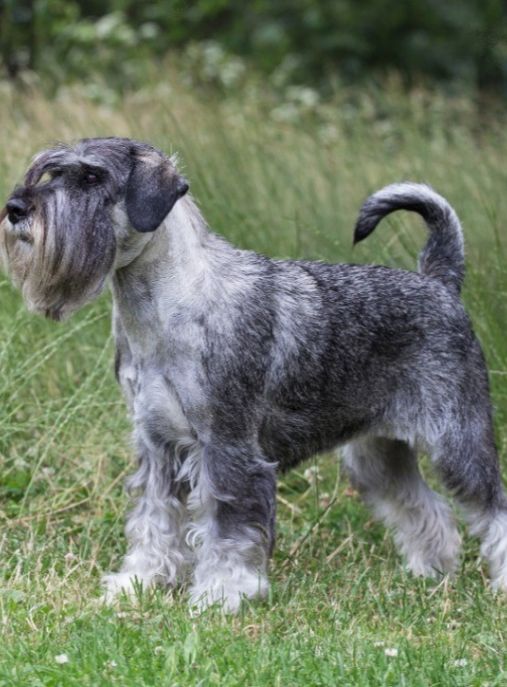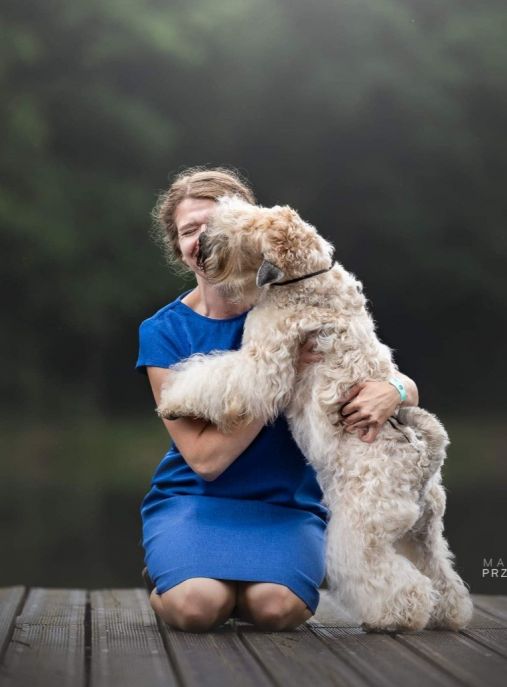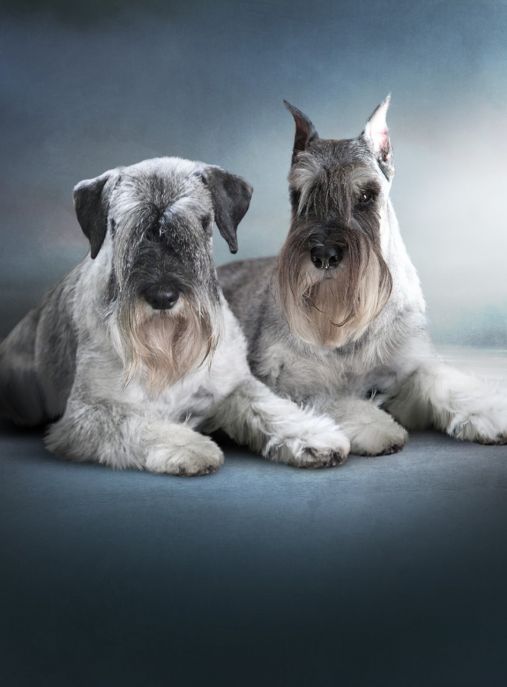The Schnauzer pepper and salt is a distinctive and charming dog breed that captures the hearts of many dog enthusiasts around the world. Known for its unique appearance and spirited personality, this breed has a rich history and a loyal following. In this comprehensive text, we will delve into the fascinating world of the Schnauzer pepper and salt, exploring its origins, characteristics, and the role it plays in the lives of its owners.
The Schnauzer pepper and salt, also known as the Standard Schnauzer, is a medium-sized breed that falls under the terrier group according to the FCI (Fédération Cynologique Internationale) typology. With its wiry double coat, distinctive beard, and bushy eyebrows, this breed possesses a dignified and alert expression. The pepper and salt coloration, which gives the breed its name, is a striking combination of black and white hairs that create a salt-and-pepper appearance.
The history of the Schnauzer pepper and salt can be traced back to Germany, where it was developed in the 19th century. It is believed to be a result of crossing the black German Poodle, the gray Wolfspitz, and the black German Pinscher. Initially, the breed was primarily used as a versatile working dog on farms, excelling in tasks such as herding livestock, guarding property, and even hunting vermin. Over time, its intelligence, loyalty, and adaptability made it a popular choice for various roles, including police and military work.
According to the FCI, the Schnauzer pepper and salt belongs to Group 2: Pinscher and Schnauzer type, Molossian type, and Swiss Mountain and Cattle Dogs. This group comprises breeds that share common characteristics, such as a robust build, a strong protective instinct, and a history of working alongside humans.
The Schnauzer pepper and salt is a breed that thrives on companionship and is known for its devotion to its family. These dogs are highly intelligent, alert, and eager to please, making them relatively easy to train. They are also known for their protective nature, making them excellent watchdogs. However, proper socialization from an early age is crucial to ensure they develop into well-rounded and friendly dogs.
In terms of physical characteristics, the Schnauzer pepper and salt typically stands at a height of 17 to 20 inches (43 to 51 cm) at the shoulder and weighs between 30 to 45 pounds (14 to 20 kg). This breed has a sturdy and muscular build, allowing it to perform various tasks with agility and endurance. The average life expectancy of a Schnauzer pepper and salt is around 12 to 15 years, although with proper care and nutrition, some individuals have been known to live even longer.
One interesting fact about the Schnauzer pepper and salt is its hypoallergenic coat. Unlike many other breeds, this breed sheds minimally, making it a suitable choice for individuals with allergies. However, regular grooming is still necessary to maintain the coat's texture and prevent matting. The breed's wiry coat requires brushing at least once a week, and professional grooming every few months to maintain its distinctive appearance.
Another notable characteristic of the Schnauzer pepper and salt is its high energy level. These dogs require regular exercise to keep them physically and mentally stimulated. Daily walks, playtime, and interactive training sessions are essential to prevent boredom and ensure a well-balanced and happy dog.
In conclusion, the Schnauzer pepper and salt is a remarkable breed with a rich history and a range of endearing qualities. From its origins as a versatile working dog to its role as a loyal companion, this breed has captured the hearts of many dog lovers worldwide. With its distinctive appearance, intelligence, and protective nature, the Schnauzer pepper and salt continues to be a cherished member of countless families, bringing joy and companionship to all who have the pleasure of sharing their lives with these remarkable dogs.
The Schnauzer Pepper and Salt dog is a breed known for its distinctive appearance and charming personality. These dogs possess a unique character that sets them apart from other breeds. With their bushy eyebrows, wiry coat, and expressive eyes, Schnauzers are instantly recognizable and have become a popular choice for dog lovers worldwide.
In terms of character, Schnauzers are often described as intelligent, alert, and spirited. They are known for their loyalty and devotion to their families, making them excellent companions and watchdogs. Despite their small to medium size, Schnauzers have a big personality and are not afraid to show it. They are confident and self-assured, which can sometimes come across as stubbornness. However, with proper training and socialization, this can be managed effectively.
One of the defining traits of Schnauzers is their high energy level. These dogs are always ready for action and require regular exercise to keep them mentally and physically stimulated. Daily walks, playtime, and interactive toys are essential to prevent boredom and destructive behavior. Schnauzers excel in various dog sports such as agility, obedience, and tracking, where they can showcase their intelligence and athleticism.
When it comes to training, Schnauzers are generally quick learners and eager to please their owners. However, their independent nature can make them a bit challenging to train at times. Consistency, positive reinforcement, and patience are key when working with these dogs. Early socialization is crucial to ensure they grow up to be well-rounded and friendly adults. Exposing them to different people, animals, and environments from a young age will help prevent any potential behavioral issues.
Schnauzers are known for their strong protective instincts, which can make them wary of strangers. While this makes them excellent watchdogs, it also means they need proper socialization to prevent them from becoming overly suspicious or aggressive towards unfamiliar people or animals. Early and ongoing socialization will help them differentiate between genuine threats and harmless situations.
In terms of grooming, Schnauzers have a unique coat that requires regular attention. Their wiry, double-layered fur needs to be hand-stripped or professionally groomed every few months to maintain its texture and prevent matting. Regular brushing is also necessary to keep their coat clean and free from tangles. Additionally, their distinctive facial hair, including their bushy eyebrows and beard, requires regular trimming to keep them looking neat and tidy.
In conclusion, Schnauzer Pepper and Salt dogs possess a character that is both endearing and unique. Their intelligence, loyalty, and spirited nature make them wonderful companions for individuals and families alike. However, they require proper training, socialization, and exercise to thrive. With the right care and attention, Schnauzers can bring immense joy and love to their owners' lives.
The Schnauzer pepper and salt dog is a charming and intelligent breed that requires proper care and attention to ensure their well-being. Here are some tips on how to care for these wonderful dogs, including what to do and what not to do:
1. Grooming: Schnauzers have a distinctive double coat that requires regular grooming. Brush their fur at least once a week to prevent matting and remove loose hair. Trim their eyebrows, beard, and mustache to maintain their characteristic look. Regularly check and clean their ears to prevent infections.
2. Bathing: Schnauzers have a coarse, wiry coat that should not be over-bathed. Aim for bathing them every 6-8 weeks or as needed. Use a gentle dog shampoo and conditioner specifically formulated for their coat type. Avoid using human products as they can be harsh on their skin.
3. Exercise: Schnauzers are an active breed and require regular exercise to keep them physically and mentally stimulated. Take them for daily walks, play fetch, or engage in interactive games. A tired Schnauzer is a happy Schnauzer, so ensure they get enough exercise to prevent boredom and destructive behavior.
4. Training: These dogs are highly intelligent and eager to please, making them relatively easy to train. Start training early and use positive reinforcement techniques such as treats, praise, and rewards. Socialize them with other dogs and people to prevent any potential aggression or shyness.
5. Mental Stimulation: Schnauzers have a sharp mind and need mental stimulation to prevent boredom. Provide them with puzzle toys, interactive games, and obedience training sessions to keep their minds active and engaged.
6. Health Care: Regular veterinary check-ups are essential to ensure your Schnauzer's overall health. Vaccinations, flea and tick prevention, and heartworm medication should be administered as recommended by your vet. Keep an eye out for any signs of illness, such as changes in appetite, behavior, or coat condition.
7. Diet: Feed your Schnauzer a balanced and nutritious diet suitable for their age, size, and activity level. Avoid overfeeding as Schnauzers are prone to weight gain, which can lead to various health issues. Consult your vet for specific dietary recommendations and portion control.
8. Dental Care: Schnauzers are prone to dental problems, so regular dental care is crucial. Brush their teeth regularly using a dog-friendly toothbrush and toothpaste. Provide dental chews or toys to help keep their teeth clean and healthy.
What not to do:
1. Do not neglect their grooming needs. Regular brushing and grooming are essential to prevent matting and maintain their coat's health.
2. Do not leave them alone for extended periods. Schnauzers are social dogs and can become anxious or develop separation anxiety if left alone for too long.
3. Do not skip training or socialization. Proper training and socialization are crucial for a well-behaved and balanced Schnauzer.
4. Do not overfeed or give them inappropriate food. Schnauzers are prone to weight gain, so it's important to feed them a balanced diet and avoid excessive treats or table scraps.
5. Do not ignore their dental care. Dental problems can lead to pain and discomfort, so regular dental care is essential for their overall health.
By following these tips and providing proper care, you can ensure that your Schnauzer pepper and salt dog leads a happy, healthy, and fulfilling life.
The Schnauzer pepper and salt color is a unique and striking feature that sets this breed apart from others. When we think of Schnauzers, the image of their distinct coat color immediately comes to mind. The pepper and salt coloration is a combination of black and white hairs, creating a beautiful and elegant appearance.
The primary color of the Schnauzer pepper and salt dogs is a dark, rich shade of gray. This gray color is often compared to the color of freshly ground black pepper, hence the name "pepper and salt." The gray hue can vary in intensity, ranging from a lighter silver-gray to a deeper charcoal shade. This variation adds depth and dimension to the dog's coat, giving it a unique and eye-catching appearance.
Intermingled with the gray hairs are white hairs, which create the "salt" aspect of the coloration. These white hairs are typically scattered throughout the coat, giving it a speckled or salt-like appearance. The distribution of white hairs can vary from dog to dog, with some having a more evenly distributed salt coloration, while others may have larger patches of white.
The pepper and salt coloration is not limited to the outer coat of the Schnauzer. It extends to their facial hair as well, including their distinctive eyebrows and beard. These facial features are often accentuated by the contrasting colors, making them stand out even more. The eyebrows, in particular, are a prominent feature of the Schnauzer breed, and the pepper and salt color adds to their expressive and intelligent appearance.
The texture of the Schnauzer's coat is another noteworthy aspect. It is typically wiry and dense, providing protection from the elements. The pepper and salt coloration further enhances the texture, giving the coat a coarse and rugged feel. This texture not only adds to the breed's unique aesthetic but also serves a functional purpose by providing insulation and protection.
The pepper and salt color of Schnauzer dogs is a highly desirable trait among enthusiasts and breeders. It is a defining characteristic of the breed and is often sought after by those looking to own a Schnauzer. The coloration not only adds to the breed's overall appeal but also contributes to their regal and dignified presence.
In conclusion, the Schnauzer pepper and salt color is a captivating blend of gray and white hairs that creates a visually stunning coat. The combination of the dark gray pepper color and the scattered white salt hairs gives the Schnauzer a distinctive and elegant appearance. This coloration, along with the breed's wiry coat texture, contributes to their unique and recognizable look. Whether it's their expressive eyebrows or their rugged coat, the pepper and salt color is an integral part of what makes Schnauzers so beloved and admired.
The health of Schnauzer pepper and salt dogs is generally robust, but like any breed, they are prone to certain health issues. Proper care and attention are crucial to ensure their well-being. In this text, we will explore the most common diseases found in Schnauzer pepper and salt dogs and provide guidance on how to care for their health.
One of the most prevalent health concerns in Schnauzers is pancreatitis. This condition occurs when the pancreas becomes inflamed, leading to symptoms such as vomiting, abdominal pain, and loss of appetite. To prevent pancreatitis, it is essential to provide a balanced diet, avoiding fatty foods and excessive treats. Regular exercise is also crucial to maintain a healthy weight, as obesity can contribute to pancreatitis.
Another common health issue in Schnauzers is urinary stones. These stones can form in the bladder or urinary tract, causing discomfort, frequent urination, and blood in the urine. To prevent urinary stones, it is important to provide fresh water at all times and ensure a balanced diet that promotes urinary health. Regular veterinary check-ups can help detect any signs of urinary stones early on.
Schnauzers are also prone to developing skin conditions, such as allergies and dermatitis. These can manifest as itching, redness, hair loss, and skin infections. Regular grooming, including brushing their coat and checking for any signs of skin irritation, is essential. A high-quality diet rich in omega-3 fatty acids can also promote healthy skin and coat. If allergies are suspected, a veterinarian can conduct tests to identify the allergen and recommend appropriate treatment.
Eye problems are another concern in Schnauzers. They are prone to developing cataracts, which can lead to vision impairment or blindness. Regular eye examinations by a veterinarian are crucial to detect any early signs of cataracts. Additionally, maintaining good dental hygiene is important, as dental issues can contribute to eye infections. Regular teeth brushing and dental check-ups can help prevent dental problems.
Regular exercise is vital for Schnauzers to maintain their overall health. They are an active breed that requires daily walks, playtime, and mental stimulation. Adequate exercise helps prevent obesity, promotes cardiovascular health, and keeps their joints and muscles strong.
Regular veterinary check-ups are essential for Schnauzers to monitor their overall health and detect any potential issues early on. Vaccinations, parasite prevention, and routine blood tests are part of a comprehensive healthcare plan for these dogs.
In conclusion, while Schnauzer pepper and salt dogs are generally healthy, they are prone to certain health conditions. By providing a balanced diet, regular exercise, proper grooming, and regular veterinary care, owners can ensure the well-being of their Schnauzers. Being proactive in their healthcare will help prevent and manage common diseases, allowing these beloved dogs to live long, happy, and healthy lives.
The Schnauzer pepper and salt dog is a popular breed known for its distinctive appearance and lively personality. As responsible pet owners, it is crucial to provide them with a well-balanced and nutritious diet to ensure their overall health and well-being. In this text, we will delve into the nutritional needs of Schnauzer pepper and salt dogs, offering advice on what and how to feed them, as well as highlighting certain foods to avoid.
First and foremost, it is important to understand that Schnauzers are a medium-sized breed with a moderate energy level. This means that they require a diet that provides them with the necessary nutrients to support their daily activities without causing excessive weight gain. A balanced diet for a Schnauzer pepper and salt dog should consist of high-quality proteins, healthy fats, and a moderate amount of carbohydrates.
Protein is an essential component of a dog's diet, as it helps build and repair tissues, supports a healthy immune system, and provides energy. Good sources of protein for Schnauzers include lean meats like chicken, turkey, and beef, as well as fish and eggs. It is important to ensure that the protein is of high quality and easily digestible to avoid any digestive issues.
Healthy fats are also crucial for Schnauzers, as they provide energy, support brain function, and help maintain healthy skin and coat. Incorporating sources of omega-3 fatty acids, such as fish oil or flaxseed oil, can be beneficial for their overall health. However, it is important to remember that fats should be given in moderation to prevent weight gain.
Carbohydrates should make up a smaller portion of a Schnauzer's diet, as they are not as essential for their overall health. However, they can still provide a source of energy. Opt for complex carbohydrates like whole grains, sweet potatoes, and vegetables, as they offer more nutritional value compared to simple carbohydrates found in processed foods.
When it comes to feeding your Schnauzer pepper and salt dog, it is recommended to divide their daily food intake into two or three meals to aid digestion and prevent bloating. The exact amount of food will depend on factors such as age, weight, activity level, and metabolism. It is best to consult with a veterinarian to determine the appropriate portion sizes for your specific dog.
While there are many foods that are safe and healthy for Schnauzers, there are also certain foods that should be avoided. Some common foods that can be toxic to dogs include chocolate, onions, garlic, grapes, raisins, avocados, and certain artificial sweeteners like xylitol. Additionally, Schnauzers are prone to pancreatitis, so it is important to avoid feeding them fatty or greasy foods.
In conclusion, providing a well-balanced and nutritious diet is essential for the health and well-being of Schnauzer pepper and salt dogs. A diet rich in high-quality proteins, healthy fats, and moderate carbohydrates will support their energy needs and overall health. Remember to feed them in appropriate portion sizes and avoid foods that can be harmful to their health. By following these guidelines and consulting with a veterinarian, you can ensure that your Schnauzer pepper and salt dog enjoys a healthy and fulfilling life.













